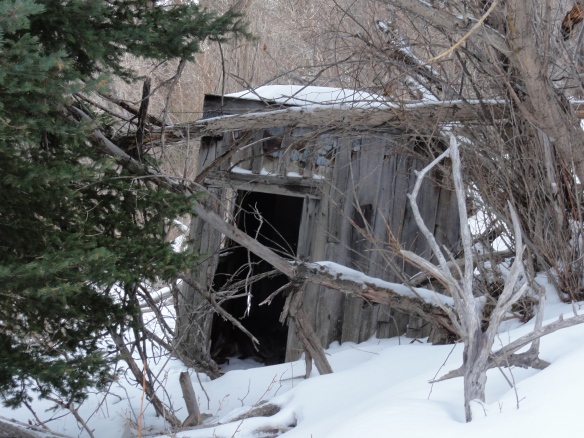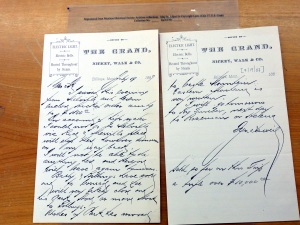Estella and William Muth lived in the tiny mining town of Belmont, Montana in 1881. Belmont no longer exists, but I did find the Belmont Mine on a map, and today we decided to put on the snowshoes and see if we could find the mine, and maybe even a cabin or two.
We started off at Ottawa Gulch, right above the town of Marysville. Marysville was a booming town of about 4,000 in the 1880’s, and Estella Muth often mentioned heading “downtown” from her house in Belmont. Marysville had a drug store, grocery, churches, a number of saloons, and a post office, which was serviced by a train that came from Helena. Today fewer than 200 people live there.
We snowshoed uphill, working our way southwest through the forest, and after about an hour of hiking we found a small structure:
 Not sure what this building was used for, but right below it was a small stamp mill:
Not sure what this building was used for, but right below it was a small stamp mill:
The stamp mill crushed the ore so that the gold could be extracted. Large stamp mills must have been incredibly noisy; the stamps pounded on the ore day and night. I’m sure that the pounding of the crushers was a constant soundtrack to Estella’s life in Belmont. Indeed, Estella mentioned in her diary that the mill kept running even after the six men were killed in the “Belmont disaster.” The Belmont stamp mill was a large one, with 30 stamps, and I learned today that it was destroyed in 1944 as a training exercise for a demolition team from nearby Fort Harrison. So this little mill that we found was not the one for the Belmont Mine. Nonetheless, it was an interesting discovery. Here are some more pictures of the stamp mill:
We didn’t find any standing cabins on this trip, but we plan to return in the summer and continue the search!
If you’re interested in more detail about how the stamp mill worked, Wikipedia has a great article.
Here are a couple of shots of Marysville today:











